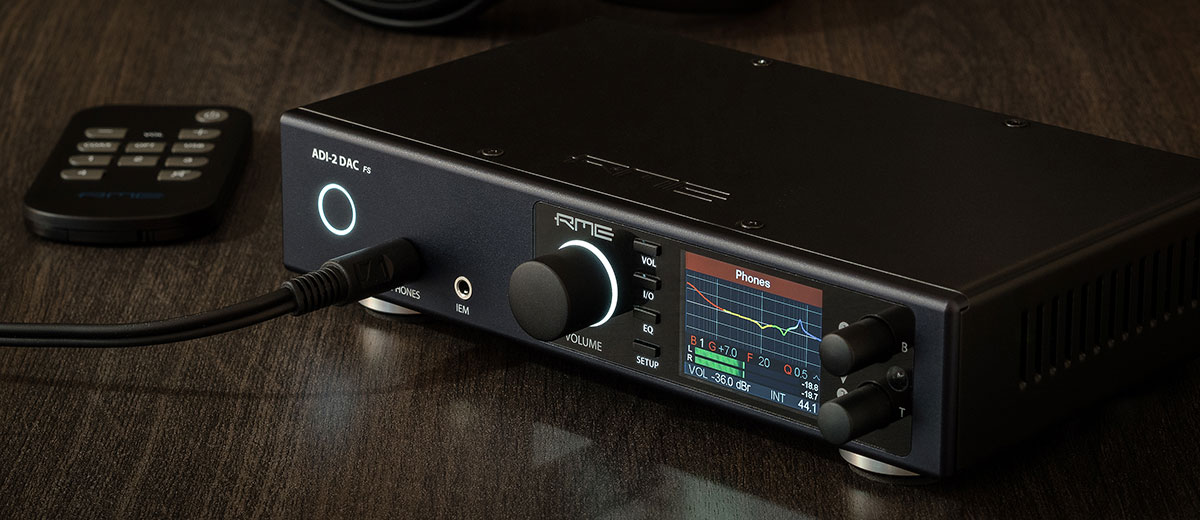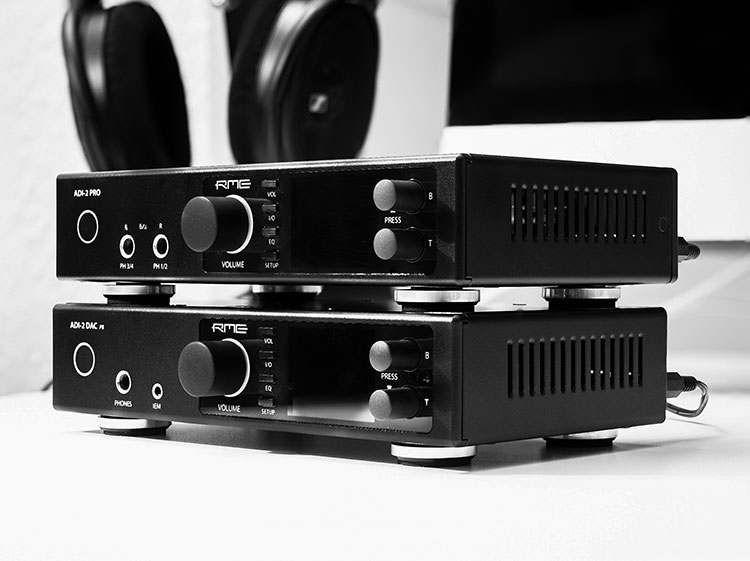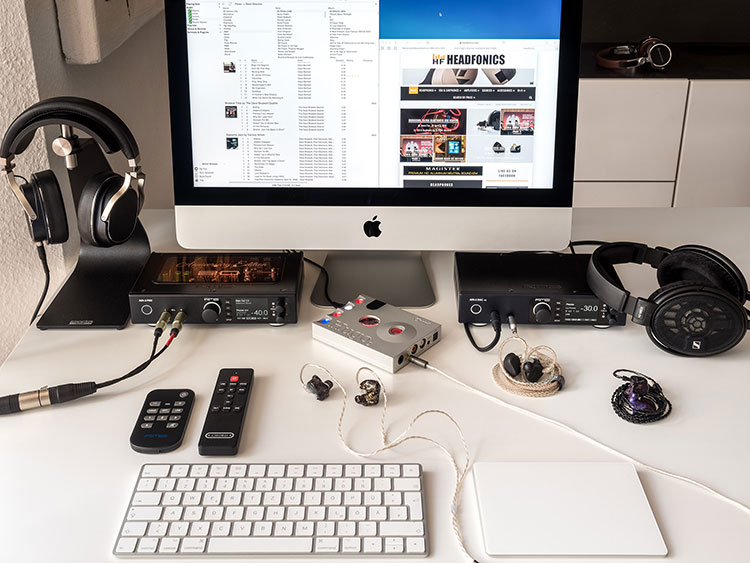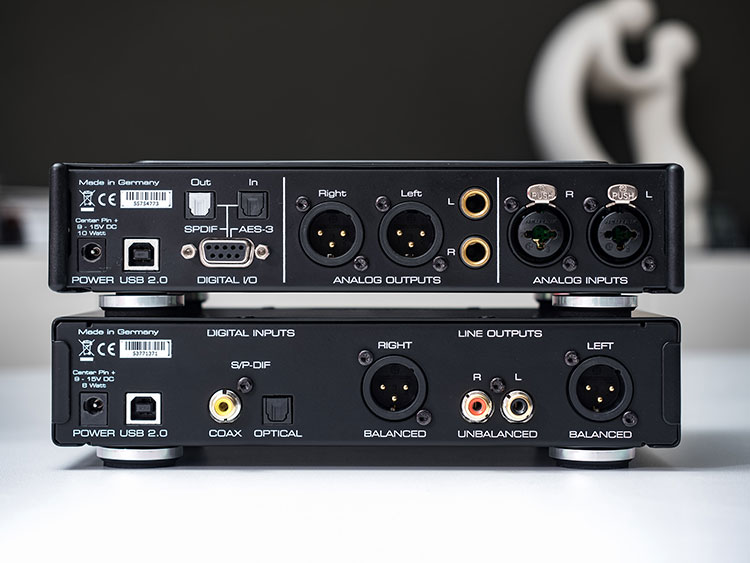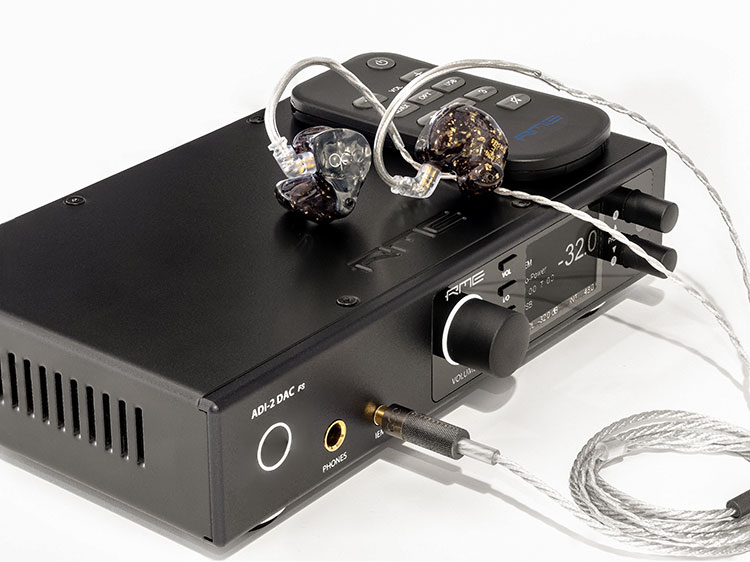DAC Features
First off, I absolutely recommend checking out the manual that describes all the features in detail. I can merely give an incomplete and abridged rundown with some subjective salt thrown into the mix. RME has a more neutral way of presenting and describing the features.
Parametric Equalizer
The ADI-2 DAC has a 5-band-parametric equalizer. You can change gain, frequency, and quality, and switch between peak and shelf on the ends to correct your favorite headphones.
You can use it as a notch filter to remove a pesky resonance peak or you can switch to dual-EQ to equalize the channels separately. That way you can use it for room corrections in your speaker setup or correct asymmetrical hearing.
You can see if you agree with my personal perception of an uncolored headphone with the following settings that I stored for the Sennheiser HD 660 S (all peak):
G +5.0 F 35 Q 0.5
G -2.0 F 1.04k Q 2.6
G -3.0 F 3.1k Q 3.7
G +1.5 F 6.0k Q 0.5
G +4.0 F 6.9k Q 5.0
Aside from the options peak and shelf, you can also use the PEQ to cut off either end of the frequency range where you see fit. This could be useful in a complex speaker setup, for monitoring, or if a recording has terrible noise in the high frequencies.
Want to know which of your Hip-Hop tracks actually uses sub-bass? Cut off everything else and only filter frequencies below 60 Hz. Or even better yet: Cut-off at 20 kHz and load HD audio with a 192kHz sampling rate to do a blind test!
Bass / Treble
I never had a home speaker amp that didn’t come with bass and treble knobs. Every room sounds different so including them makes a lot of sense. These knobs are easily accessible on the front panel.
With the ADI-2 DAC, you can also reprogram the function so you can choose which part of the treble or bass you want to be adjusted. More warmth, more punch, more sub-bass? Your choice.
It also comes in handy when you need that quick temporary adrenaline fix with some hard-hitting beats or if a single recording is too hot. The adjustments are added on top of active equalizers.
Loudness
According to the equal-loudness contour (or Fletcher-Munson curve) our ears do not perceive volume the same at lower or higher volumes.
Especially at lower volumes the threshold for bass drops exponentially. So if you were to turn down the volume, you would have to retune bass and treble with every volume step. The RME calculates that for you over the range of 20 dB.
Of course, this can also be reconfigured to personal taste. By default, bass and treble will be boosted by 7 dB if you drop the volume by 20 dB. Personally, I think values around +10 for bass and +3 for treble are more accurate.
You have to set your personal threshold in the menu and from then on you don’t have to worry about the bass / treble adjustments anymore. Your ENT doctor suggests: enjoy your music safely and lower the volume from time to time.
Crossfeed
I love crossfeed. I use it all the time. My first serious head-amp was the Meier Corda Jazz because it had crossfeed. Usually, recordings are mixed for speakers in a stereo setup. This results in strong channel separation that can cause fatigue when listening over headphones.
RME gives you 5 options to remedy this. The 2nd option is actually based on Jan Meier and thus is a DSP emulation of the hardware crossfeed found on Corda amps. The 4th option is supposed to emulate a stereo speaker placement at 30 degrees at a 3m distance.
The experience is definitely not as strong as some gimmicky head tracking or surround emulations, but for that, they stay clean and precise. Except for the 5th option, I haven’t noticed any mud or lack of resolution introduced.
As I often see false information: These are not equalizer settings! Crossfeed considers the time domain and treble adjustments of the opposite channel. Also, crossfeed is not the same as crosstalk. The latter is information with the wrong polarity, effectively damaging the signal.
Width
If you are not a fan of crossfeed, maybe a more linear adjustment of channel separation interests you? By default, the value 1.0 is truthful to the source. Lowering it down to 0 in 0.01 steps will give you a mono signal. If it floats your boat, you can also reverse the channels with a minimum value of -1.
Listening to mono recordings, this feature doesn’t change anything. It’s hardly added value, but it does help to compare soundstage width between two earphones when AB testing.
DA Filters
Truth be told, I do not enjoy taking on this topic. There is a lot of discussion about filters but in the end, my ears just don’t seem sensible enough to reliably describe the sonic effects apart of treble roll-off. So here is my best trying to describe what is happening.
The aim is to provide the cleanest signal possible, but it needs some balancing between changing the impulse response, shifting the phase and its aftermaths of shaping the distortion.
Short-Delay Sharp
The default option on the DAC is Short-Delay Sharp. This is a minimal phase filter without pre-ringing. It has the least amount of aliasing and creates the least amount of harmonics. However, it also has the worst temporal resolution, showing the longest post-ringing. This is supposed to give the audio what some describe as an analog feel. The treble does not roll off.
Sharp
Alternatively, there is a linear phase version of the Sharp filter. I believe this is the default option for most D/A converters that do not provide any filter options. It has similar characteristics but less post-ringing.
For that, it introduces pre-ringing. That means not only (stronger) harmonics are an issue, but also aliasing distortion is introduced by the pre-ringing theoretically resulting in overall more noise in the audible spectrum.
Slow
The Slow filter greatly reduces post- and pre-ringing of the impulse response compared to Sharp. One of the side effects, however, is that it oversamples above the Nyquist frequency, which creates unwanted noise, especially from the pre-ringing.
Using Short-Delay Slow instead will result in noise shaping which is supposed to push the aliasing distortion outside the hearing range. It will scale with the sampling rate and it should perform better with higher sample rates. Noticeable treble roll-off can be countered simply with the PEQ.
NOS
Finally, the fifth filter is known as NOS (non-oversampling) or Super Slow. It creates a perfect impulse response with neither pre- nor post-ringing. The price to pay is an even stronger treble roll-off and the most aliasing distortion across the frequency range. Whether this is audible or not, is for you to decide.
I think the differences apart from treble roll-off are mostly outside the human’s hearing capability. But I do not want to create any bias so best you try for yourself.
Balance
Many people have asymmetrical hearing. By medical standards, it takes a difference of 25 dB between the left and right ear. We audiophiles are a lot pickier than that, of course. The ADI-2 DAC lets you change the channel in percentage.
I suggest you take three earphones (with good channel matching), and a good mono recording (Frank Sinatra, The Beatles), close your eyes, and use the knob to center the audio in your mind. Chances are very high that you won’t perfectly hit the center. (I ended up with a .4 dB emphasis on one side.)
In the long run, this is a revelation, although the ideal way would be to use the dual EQ to separate the differences according to frequencies. That is probably impossible to achieve without some help or a lot of experience, though, so for a quick and easy fix the Balance option is more than welcome.
Polarity
A very handy feature for me is that you can switch the electrical polarity quite easily in the menu. Just recently a company sent me a set of earphones for review that sounded completely off. The tonality was good, but the sound just didn’t carry any musicality. I didn’t expect a technical error so I was leaning towards fit issues.
Luckily, I quickly uncovered the issue with the ADI-2 DAC. Switching the polarity on either L or R fixed the sound and I had to send the earphones back for repair because obviously it was wired wrong.
If your gear isn’t broken, you can also switch the polarity on both sides and figure out for yourself if you can hear absolute phase or not. Some people claim they can. Now they can prove it in a blind test!
SteadyClock FS
RME created a new self-developed clock with an ultra-low jitter. Jitter occurs when the conversion from digital to analog introduces time differences. The period in which the DAC samples have to remain steady or the time-varying signals known as sampling jitter will create distortions. There is a very detailed article by Yuri here.
The new SteadyClock FS is accurate in measurements of femtoseconds. That means there are very low deviations. Easily put: a better clock equals less jitter equals a cleaner signal.
Bit-Perfect
This is probably hardly a feature but more like the very least, one would expect from a high-end DAC. However, the useful option here is that you can test your input source for bit accuracy!
You can test if your music software or your source hardware changes the audio in any way. This is extremely useful if you have the impression that software A sounds better than B.
Maybe there is some hidden DSP involved or the other program lied about specifications. All kinds of unwanted change are imaginable, but at least now you have a starting point or a valid test to prove your sanity.
Handling of Direct Stream Digital (DSD256) and 32 Bit 768 kHz audio
In theory, DSD is a good way of preserving audio. It uses noise shaping to push noise into ultrasonic frequencies leaving human ears with a clean and distortion-free audio track. Even though the SACD was considered dead, the medium now starts to gain popularity again thanks to more hardware being able to decode the information.
DSD Direct Mode
The ADI-2 DAC features a DSD Direct mode in which the DAC preserves the DSD format. However, the 1 Bitstream does not allow any DSP adjustments, including volume control. So if you are using headphones, the data will be converted to PCM.
PCM
The RME can handle PCM up to 32 Bit 768 kHz. Sample rates above 384 kHz (e.g. 5 times 44,1 or 48 kHz) will have some limitations, though, e.g. the loudness function will be deactivated (including separate bass and treble corrections) and Crossfeed and EQ cannot be active at the same time. That’s when the DSP with over 2 GigaFLOPS and custom FPGA reaches its limit.
Phew, what a list. I hope that by my simplified explanations, you can see a reason for why the options are there and also maybe help you use them. They really make reviewing headphones easier for me and they boost my experience of just enjoying music.
There are even some more features like M/S Processing (for mixing center information) or Auto De-Emphasis (for fixing bright masters) that I do not consider important for the average consumer.
Sound Impressions
The RME boasts some impressive specifications for the price and size offered. By now many objective measurement sites have confirmed extremely low jitter, superb channel matching and separation, flat linearity, extremely low harmonic and intermodulation distortion, close to zero ohms output impedance on the headphone out, and a high dynamic range.
(You’ll find the full list of specs at the end of the review.) But does that tell us anything about the sound?
Transparency
The whole point or philosophy of the ADI-2 Pro was to build a transparent device that RME could use to measure other equipment. That same design has been taken over by the DAC. As it happens, that is exactly what fans of high-fidelity want and need. An uncolored sound that is faithful to the headphones and the rest of the audio chain, respectively.
From experience, I know that some audiophiles enjoy added warmth or even unknowingly enjoy low-end distortion. They want every device to have its own character and unique sound.
This, you will not get from the RME unless you tweak its settings to do so purposely. If you are looking for something special or a unique sonic trait, you won’t find it here. The performance is balanced across the board.
In the past, I have reviewed some gear that to me sounded darker and more intimate. Less frequently, I have also come across sources that sounded brighter and more open. Going by my observations, internationally, I think many readers are accustomed to warmer-sounding gear.
I read impressions on the ADI-2 Pro that few people thought it sounded almost bright. You are less likely to find agreement in the German audio scene and compared to other German amps like Corda Audio, Lake People/ Violectric, or Lehmann Audio, the tonality is pretty much in-line if not even a bit meatier but still lightweight.
Select Comparisons
RME ADI-2 DAC vs ADI-2 Pro Anniversary Edition
In the past, I compared the ADI-2 Pro to Benchmark DAC3 HGC, Lake People (Violectric) Reference Series DAC and Amp, and the Chord Hugo – all on Headfonics.
My findings were based on direct A/B comparisons so I suggest checking them out instead of me writing down something from memory. So, for now, I will focus mostly on differences with the already established ADI-2 Pro in this review.
The two devices are closely connected and by now the ADI-2 Pro has become quite familiar. Users are probably interested in where the difference to the ADI-2 DAC is. Thus this part has been given some more space.
Build Quality
As mentioned earlier, the build quality is identical on all three variants of the device. Or is it? I noticed some small changes. The light around the power knob of the new DAC is more evenly illuminated and slightly brighter. When turned on, the white glow is slightly warmer.
Also, the display itself is brighter, though I usually dial it down to 30% in the settings anyway. The monitor’s color balance can be adjusted in the settings, so there is no need to compare the color tone. Due to the acrylic glass top of the Pro version, the screw placement is different.
One more difference that I noticed is that the Anniversary Edition generates much more heat while the ADI-2 DAC stays fairly cool even after hours of use.
Connectivity
The backside shows more differences. Of course, the DAC does not have an A/D converter and thus lacks all the analog inputs of which the Pro features AES balanced and 1/4 inch unbalanced. This way the DAC has more space on the backside and does not need to use a proprietary digital I/O twig.
Coaxial input is easier to access this way, though there are no more digital outputs. The rear pre-amp output now features regular unbalanced cinch connections aside from the XLR balanced output. The remote control is exclusive to the ADI-2 DAC.
Hardware
The whole A/D circuitry with the quad-mono AK5574 chip is gone on the DAC. But also a second AK4490EQ chip went amiss that was used for the balanced headphone amplification on the Pro version (2 outputs times 2 channels). But even with a single high-end DAC chip, the ADI-2 DAC is still fully balanced internally.
A more prominent difference in hardware is the updated clock in the DAC that now further reduces jitter thanks to femtosecond accuracy, hence the addition of ADI-2 DAC FS.
Do note that the update has swamped over to the regular ADI-2 Pro. The latest revisions are now called ADI-2 Pro FS and are available for the same price as before. Since the update needs a new circuit board, older devices cannot be upgraded.
Sound Comparisons
Both Uncolored
How does the sound of the two devices compare? Now, I can make this short because, seriously, I tried and tried but couldn’t tell the difference in a real field test. Apart from paper, both devices sound similar.
That means an uncolored, transparent, and clear sound. The new SteadyClock FS seems to be a great improvement, but unless you microscope measurement data on a display so that your eyes can see it, your ears probably won’t be able to pick up a difference.
If you are rooting for the Pro because of the option of using a balanced headphone output, my experience might or might not make sense to you. If you have a good unbalanced cable on your headphones, there is probably nothing for you to improve anymore.
You can test this easily with the RME ADI-2 Pro/DAC: go to I/O > Output Settings > Balance and turn it all the way to either left or right. Now play a signal that only has information on one channel. If the other is completely mute, then your cable is fine.
Cables
From my experience, quite a few cables introduce very audible crosstalk. Switching to balanced amplification would remove that error, however, a better-unbalanced cable can do the same. Of course, this is only true if the output is as clean – which is the case with the ADI-2 Pro/DAC.
You do get a +6 dB boost (with 3 dB higher dynamic range) and an insane 20 VRms which could potentially make a difference with very power-hungry headphones. Whether it’s worth it will depend on the efficiency of your headphones.
IEMs
On the other hand, the DAC has the exclusive IEM output. It’s a super low noise output to enhance the signal of a super-sensitive head- or earphone. With the Sennheiser HD 660 S and Oppo PM-3, I still have around 20 dB left so there is enough power to heat up sensitive full-size headphones.
Since the volume regulation of the 1/4 inch output is super precise, it can also handle sensitive IEMs and even provides greater headroom. So when does the IEM output start to make sense? If you are a crazy attentive listener who picks up even the slightest noise, the Campfire Andromeda, Vision Ears VE8, and qdc Gemini can unveil a very slight background noise of the original output.
I did not notice this before, but eventually, I did manage to pick it up on the ADI-2 Pro. So yes, the IEM output can introduce a darker black background that my mind interprets as a larger soundstage and higher precision with faster decay.
So there you have it. Which one better suits your needs? In general, I would say the DAC is the easy recommendation over the Pro unless you either detest IEMs and only bring the big guns, or if you need two perfectly matched outputs for A/B testing.
Chord Hugo 2
Compared to the Chord Hugo 2, I feel like the RME sounds more vivid in the midrange. But I guess it is because of Chord’s WTA filters that make the treble sound more extended. When using very power-hungry headphones, the RME provides a stronger ground while the sound can get grittier or brittle when nearing the max power of the Chord.
With very sensitive IEMs, I feel like the Hugo 2 is even tighter in the bass despite having more audible hiss when compared to the Phones output of the RME. This changes, however, when I switch to RME’s IEM output which improves clarity and precision.
All in all, the RME is more versatile and ultimately impresses more with both, headphones that need low-volume precision and those that need power. Of course, the RME has the advantage of size and external PSU whereas the Hugo 2 is a fully portable device.
Our Verdict
I can’t think of any other desktop DAC/amp combo that would be easier to recommend in 2018. There is no magic involved in the RME ADI-2 DAC: no proprietary filters, no patented exclusive circuits, no unordinary connections, and most importantly no voodoo buzzwords.
This is an extremely down-to-earth device that has just been given extreme thought, massive experience, and great attention to detail. It’s not the supplier’s chip that makes a great device, it is how you use the tools.
The ADI-2 DAC is technically marvelous, regardless of whether you want to dive into the long feature list or not. I do recommend you do, though, because the equalizer with its many save slots, the customizable loudness function, the tight crossfeed, various DA filters, and many controls to test your whole audio chain just keep on giving and giving.
Despite the huge amount of functions, the software is extremely stable and hasn’t failed me once.
While the headphone output provides clean and linear amplification for even power-hungry headphones, the new IEM output might just have reached a new reference level. Of course, the device will work just as well as a standalone DAC in case you want to connect some warm tubes with the line-out. The channel-specific dual EQ or quick bass/treble adjustments can work wonders for a speaker setup.
I praised the RME ADI-2 Pro before and it proved to be a massive success. At 1.599 € (or 1.999 € for the Black Anniversary Edition) it challenged competitive high-end products and it seems almost unfair that we now can get the same performance for a lot less, e.g. 999 €. Friends of high-fidelity, what are you waiting for?
RME ADI-2 DAC Technical Specifications
Digital Inputs
General
- Lock Range: 28 kHz – 200 kHz
- Jitter suppression: > 50 dB (2.4 kHz)
- Accepts Consumer and Professional format
SPDIF coaxial
- 1 x RCA, according to IEC 60958
- High-sensitivity input stage (< 0.3 Vpp)
- AES/EBU compatible (AES3-1992)
SPDIF optical
- 1 x optical, according to IEC 60958
- ADAT compatible
Analog Outputs
XLR
- Output level switchable +19 dBu, +13 dBu, +7 dBu, +1 dBu @ 0 dBFS
- Signal to Noise ratio (SNR) @ +7/+13/+19 dBu: 117 dB RMS unweighted, 120 dBA
- Signal to Noise ratio (SNR) @ +1 dBu: 115,4 dB RMS unweighted, 118,9 dBA
- Frequency response @ 44.1 kHz, -0.1 dB: 0 Hz – 20.2 kHz
- Frequency response @ 96 kHz, -0.5 dB: 0 Hz – 44.9 kHz
- Frequency response @ 192 kHz, -1 dB: 0 Hz – 88 kHz
- Frequency response @ 384 kHz, -1 dB: 0 Hz – 115 kHz
- Frequency response @ 768 kHz, -3 dB: 0 Hz – 109 kHz
- THD @ -1 dBFS: -112 dB, 0.00025 %
- THD+N @ -1 dBFS: -110 dB, 0.00032 %
- THD @ -3 dBFS: -116 dB, 0.00016 %
- Channel separation: > 120 dB
- Output impedance: 200 Ohm balanced, 100 Ohm unbalanced
Chinch
As output XLR, but:
- Output: 6.3 mm TS jack, unbalanced
- Output level 6 dB lower than XLR (-5 dBu to +13 dBu @ 0 dBFS)
- Signal to Noise ratio (SNR) @ +13 dBu: 117 dB RMS unweighted, 120 dBA
- Signal to Noise ratio (SNR) @ +1/+7 dBu: 114/116 dB RMS unweighted, 117/119 dBA
- Signal to Noise ratio (SNR) @ -5 dBu: 109 dB RMS unweighted, 113 dBA
Phones
As Cinch but:
- Output: 6.3 mm TRS jack, unbalanced, stereo
- Output impedance: 0.1 Ohm
- Signal to Noise ratio (SNR) @ +22 dBu: 117 dB RMS unweighted, 120 dBA
- Signal to Noise ratio (SNR) @ +7 dBu: 116 dB RMS unweighted, 119 dBA
- Output level at 0 dBFS, High Power, load 100 Ohm or up: +22 dBu (10 V)
- Output level at 0 dBFS, Low Power, load 8 Ohm or up: +7 dBu (1.73 V)
- THD @ +18 dBu, 32 Ohm load, 1.2 Watt: -110 dB, 0.0003 %
- THD+N @ + 18 dBu, 32 Ohm load: -107 dB, 0.00045 %
- THD @ +14 dBu, 16 Ohm load, 0.94 Watt: -110 dB, 0.0003 %
- Max power @ 0.001% THD: 1.5 W per channel
IEM
As Phones, but:
- Output level at 0 dBFS: -3 dBu, 0.55 V
- Signal to Noise ratio (SNR) @ -3 dBu: 115 dB RMS unweighted, 118 dBA
- Max power, 8 Ohm, 0.001% THD: 40 mW per channel
Digital
- Clocks: Internal, SPDIF In
- Low Jitter Design: < 1 ns in PLL mode, all inputs
- Internal clock: < 800 ps Jitter, Random Spread Spectrum
- Jitter suppression of external clocks: > 50 dB (2.4 kHz)
- Effective clock jitter influence on DA conversion: near zero
- PLL ensures zero dropouts, even at more than 100 ns jitter
- Additional Digital Bitclock PLL for trouble-free varispeed ADAT operation
- Supported sample rates for external clocks: 28 kHz up to 200 kHz
- Internally supported sample rates: 44.1 kHz up to 768 kHz
General
- Included power supply: external switching PSU, 100 – 240 V AC, 2 A, 24 Watts
- Standby power consumption: 120 mW (10 mA)
- Idle power consumption: 7 Watts, Max. power consumption: 18 Watts
- Idle current at 12 V: 570 mA (6.8 Watts)
- Dimensions (WxHxD): 215 x 52 x 150 mm (8.5″ x 2.05″ x 5.9″)
- Weight: 1.0 kg ( 2.2 lbs)
- Temperature range: +5° up to +50° Celsius (41° F up to 122°F)
- Relative humidity: < 75%, non condensing

